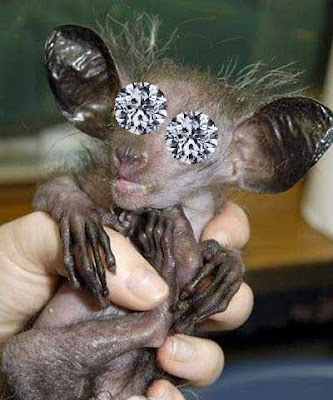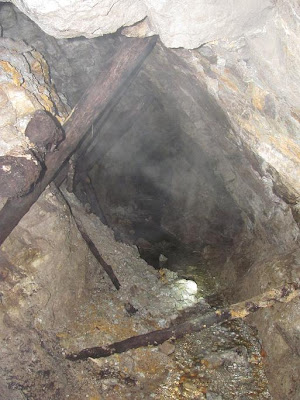Today's ghost town is one of the older places in Utah, and is also has a somewhat cooler name than most. I speak of the town of Diamond.

Sadly, unlike a real diamond, the town Diamond came and went pretty quickly. Probably the best part of having a town with a cool name is the possibilities it opens for high school mascots. Everything sounds cool with "diamond" sitting in front of it. For example, this is the Aye-Aye.

Even when it is young, it looks like sun-baked pig corpse wrapped in leather rope. It scurries around in the middle of the night because it is far too hard to sneak up on something in the daytime when you look like a lost mardi gras float. And it doesn't even do all that well at night! The name Aye-Aye comes from the noise that the native folks of Madagascar used to make when they saw it. I'm not sure about this, but I think it means "Creature from the devil's crotch". In short, no self-respecting high school would want to use the Aye-Aye as a mascot. But what if you were in Diamond?

Bam! Diamond Aye-Ayes. I would die to defend such a creature. But we've gotten off-track. Let's get down to the nitty-gritty.
In the year 1869 (which is a long time ago), the land around Diamond looked....probably exactly like it does now. Ticks were the top of the food chain, followed by rattlesnakes, coyotes, ticks again, and then probably some sort of plant. Let's take another look at what I'm talking about...

A land so bleak that angels weep upon visiting. And what do we use ugly land for? Cows! We use it for cows! And this sets the backdrop for the beginnings of Diamond.

Steve Moore wasn't a rich man. He wasn't even an important man. In fact, once we are done within this intro you won't be hearing from him again. But for this paragraph and a little bit of the next one he's very important. Cows (in addition to being tasty) like to wander. This is a pain for people who raise cows because you don't get paid for cows that you no longer own, and so it is in your interests to keep track of all the cows you can. Steve Moore was busy doing that very thing one dusty day in September of 1869. He followed the clues (mounds of cow turds) up a small canyon on the western foothills of the Tintic Mountains. It's this area....

I don't know how helpful that map is going to be. If you were to visit that canyon, this is what you would see.

Those mines weren't there back in 1869, so ignore them. Anyway, I don't know if Mr. Moore ever found his cows, but he did find something of else. Diamonds! Precious diamonds! Treasure of the Gods! Littering the ground! Cows are good, but diamonds are way better. Mr. Moore ran down the canyon with pockets filled with diamonds and showed them to his buddies. They hooted and whistled and threw their hats in the air (probably, I wasn't there), and they named their canyon "Diamond Canyon" because originality wasn't a prospector's strongest suit. Anyway, turns out the diamonds were just worthless quartz, but you don't throw away a catchy name just because it's a horrible lie.
The story could end right there and we would have very little left to talk about, but something else was discovered while everyone was busy filling their pockets with disappointment. Copper, silver and gold were discovered as well! Veins of galena and pyrite were found on the surface, both shoved full of valuable earth goods!! Silver, gold and copper are also better than cows. Cows are actually pretty far down on the list of valuable things, clocking in at number 476, right after a bucket of broken hot wheels and right above the wail of an ill-tempered toddler.
Anyway, after the whole diamond debacle, this was a bit of welcome news. This discovery lead to the creation of the Tintic Mining District. By 1870, the hills around Diamond Canyon were filled with this guy....

And wherever that guy goes, towns are soon to follow. First come crude, little miners cabins made from logs, weeds, poor-hygiene and mud. If a town is lucky enough to endure beyond this first stage, stone buildings will start to emerge. The next step is a mono-rail. Diamond never quite made it to the mono-rail stage, but spent most of its time in stage two. The town was named Diamond because even back then the miners knew a cool name when they saw it. The mines around the site were so rich that even the hobos wore tuxedos, and monocle-manufacture was up nearly 8000% within one year of the town's creation (this part I'm making up). The main mines around town included the Joe Bowers...



The Showers and Walker




As an interesting (not all that interesting) sidenote, the Showers Mine had only inclined headframe (those big wooden structures that allow people to get up and down in mines) in the west. Why did they do this? Why should you care? I haven't the foggiest. But still kinda neat to look at.

That photo was taken in 1982. Since then, the headframe has become even more inclined. Some would say that it has become dangerously inclined.

And finally, the Shoebridge Bonanza


The ore from these mines was so rich that it was shipped all the way to Wales because there wasn't anyone in the US who could deal with it. And they still made a profit! Precious, precious profits. And wherever there is a profit, there needs to be a place to spend it. Within one year of the discovery of the not-diamonds, a town boasting 4 stores, 3 hotels, 5 saloons, a post office, and an unfortunately-named newspaper named "The Rocky Mountain Husbandman". This newspaper allowed the wealthy newcomers a chance to read up on the latest badger-related fatalities, then turn the page and read an article concerning the latest improvements in top-hat repair. Old timesy rich people were funnier than nowaday rich people.

By 1871, the town had a population of nearly 900 people, which is pretty impressive considering most people couldn't expect to see their 40th birthday. At first, town was located on the canyon bottom but soon it spread up onto the nearby hills closer to the mines. Very few pictures of the place exist, as no one really thought to take pictures of towns back then.

That mountain in the back is the same mountain as this picture. Or at least I think it is. Who can tell.

So that gives you a little perspective of what is left. Which is to say, nothing at all. That same year a large mill was constructed within the city limits to help process the ores coming out of their mines. Like a drunken uncle at opera, it was considered to be a fairly crude operation and didn't last long.
The town was a rough place (as mining camps tended to be), and it was once said of the place; "Diamond is the chief camp of the Tintic Mining District, and is one of the quietest mining camps in Utah. It has been several days now since a murder has been committed". I'm assuming that comment was meant to be hilarious, and it probably was back in 1880. Some things don't age well though.
But as we've seen several times, towns that are tied to mining rarely need to come up with long-term civic planning. By 1890, the mines around town faced the unconquerable foe of water. At a depth of 300 feet, water was pouring into the mines faster than the primitive steam pumps could keep it out. One by one the mines called it quits, despite the fact that good ore still remained. With the mines all flooded, the miners soon started to migrate north to the richer mines (that didn't require gills to work) by Eureka and Mammoth. They took most of their houses with them.
From 1890 to 1900, the town was somewhat maintained by the fact that you could dig anywhere and find ore, but you could only mine it to a depth of 300 feet before things got particularly moist. By 1900 the population of Diamond was down to a brave 264 people and only three businesses. Then, sadly, in 1923 the last house was removed from the townsite and shipped off to a new life in Mammoth. This was a poor choice on the house's part, as Mammoth would join Utah's list of ghost towns a few years later. Well kinda. A few people still live there. But they all seem to have really mean-looking dogs and don't care for us outsiders.
As has been true with most ghost towns we've looked at, the only remaining signs of one-time township are the mine dumps and the graveyards. The mine dumps we've seen, but where is the graveyard? I'll tell you how to find it. Just walk around until you find a place where you feel really creeped out. Then you'll know you've found it. Now, I'm no ghostologist, but the place gave me the heebie-jeebies.

That's the main gate. So you can pretty much tell the place is haunted from the start. It's nice to get the uncertainty out of the way early. The gravestones have all long ago been lost, but a few replacements are still found between the bushes....

(This tribute to our mother's name
Her loving children raise
Yet feel that neither words nor fame
Can tell our love and praise)


Sometimes the gravestones didn't get replaced in time so we no longer know who's down there. In that case, they get a simple yet elegant rock.

The graveyard was full of rocks. One of them belongs to this fellow...

That mean-looking fellow is Henry Green, and he died in August of 1887 and joined the other lonely souls in the Diamond graveyard. I added that picture because that's the only picture I can find of anything having to do with Diamond. So enjoy it.
The Diamond graveyard is actually supposed to be somewhat haunted. The townsite would be too if there were anything left. I couldn't even find a hole in the ground or an old tin can. So if you go out there, prepare to be disappointed and haunted. Probably by this guy.
































